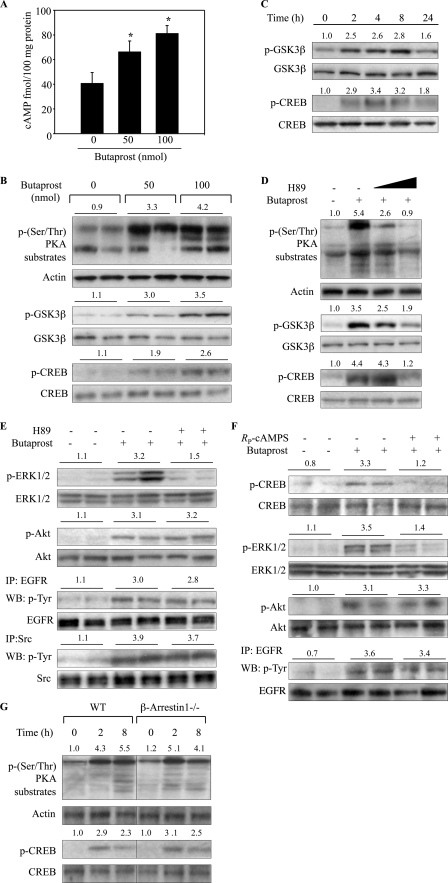FIGURE 5.
Butaprost activated the cAMP/PKA pathway. A, butaprost induced cAMP production. Mice were treated with butaprost (50 or 100 nmol) for 2 h, and tissue lysates (100 μg protein) were assayed for cAMP levels as described under “Experimental Procedures.” Values are means ± S.D. (n = 5). *, p < 0.05 versus vehicle-treated mice. B, butaprost induced dose-dependent phosphorylation of PKA substrates, GSK3β, and CREB. Mice were sacrificed at 2 h after 50 or 100 nmol of butaprost treatment. C, butaprost (100 nmol) induced time-dependent phosphorylation of GSK3β and CREB. D, H89 dose-dependently decreased PKA activity. Mice were treated with H89 (100 or 500 nmol) for 30 min before butaprost (100 nmol) treatment, and skin sections were isolated 2 h later. E, H89 suppressed butaprost-induced phosphorylation of ERK1/2 but not Akt, EGFR, or Src. Mice were pretreated with H89 (500 nmol) for 30 min and then treated with 100 nmol of butaprost for 2 h. Skin lysates were immunoprecipitated (IP) with an anti-EGFR or an anti-Src antibody and immunoblotted (WB) with an anti-p-Tyr antibody. Total EGFR and Src served as controls for protein loading and membrane transfer. F, the PKA inhibitor, RP-cAMPS, suppressed butaprost-induced phosphorylation of CREB and ERK1/2 but not Akt or EGFR. Mice were pretreated with RP-cAMPS (12 nmol) for 30 min and then treated with 100 nmol of butaprost for 2 h. Skin lysates were immunoprecipitated with an anti-EGFR antibody and immunoblotted with an anti-p-Tyr antibody. G, butaprost induced phosphorylation of PKA substrates and CREB in both WT and β-arrestin1−/− mice. WT and β-arrestin1−/− mice were treated for the indicated times with 100 nmol of butaprost. In B–G, skin lysates (80 μg) were immunoblotted with the indicated antibodies. The number above each lane shows the relative intensities of the bands as described in the legend for Fig. 1. The data are representative of two independent experiments. In B, E, and F, each lane represents an individual mouse. The number above each lane shows the mean -fold intensities for two mice.

